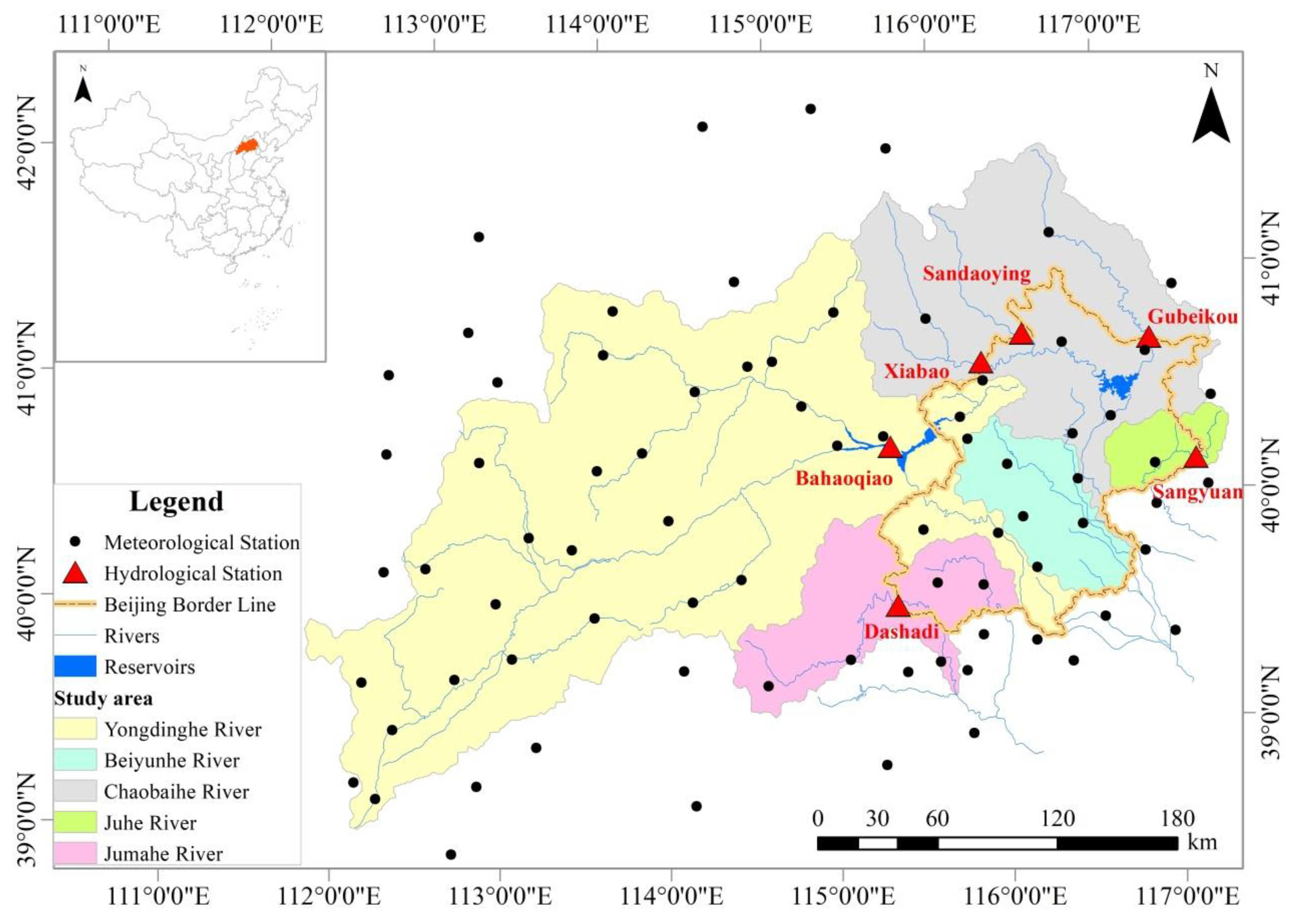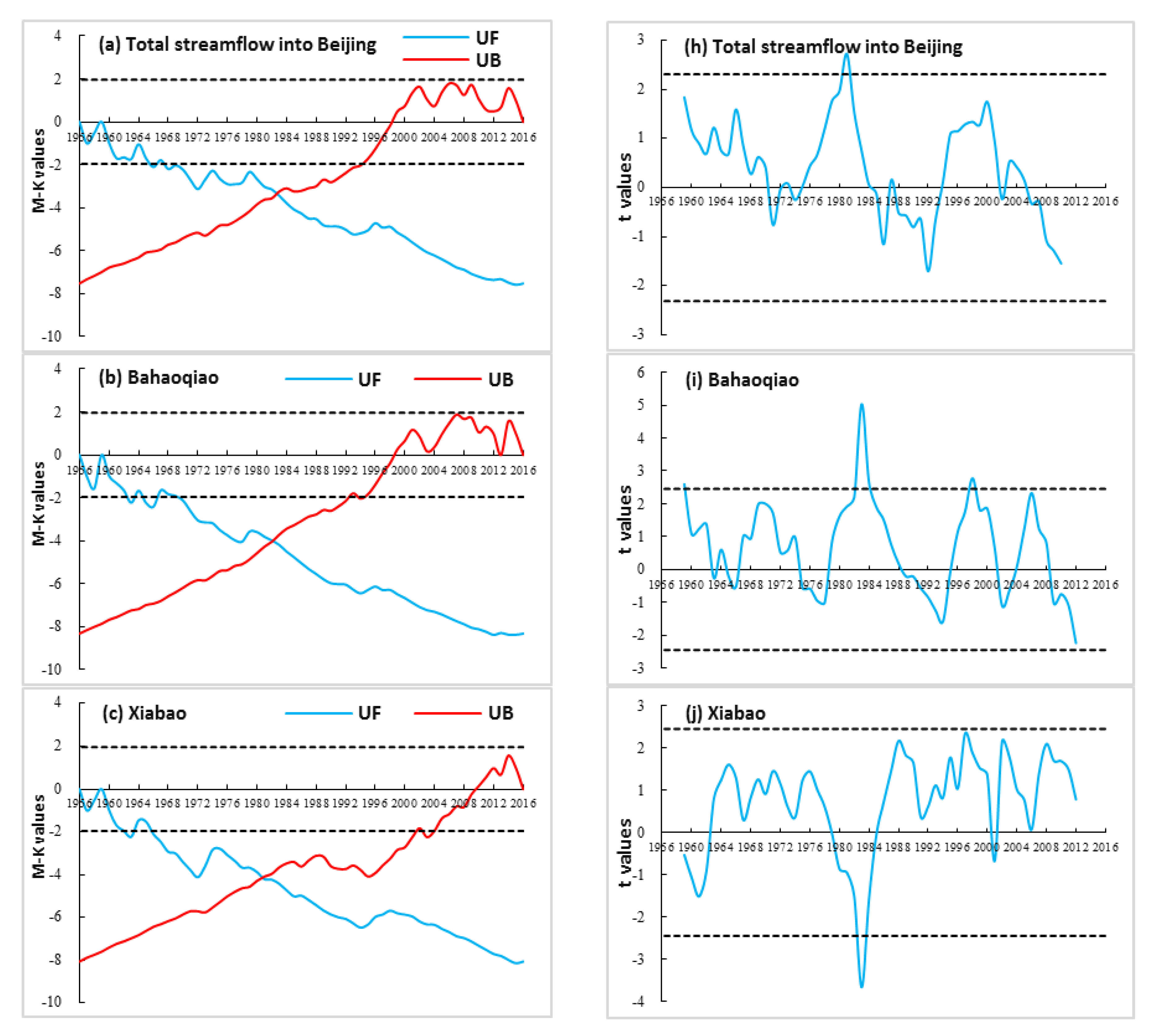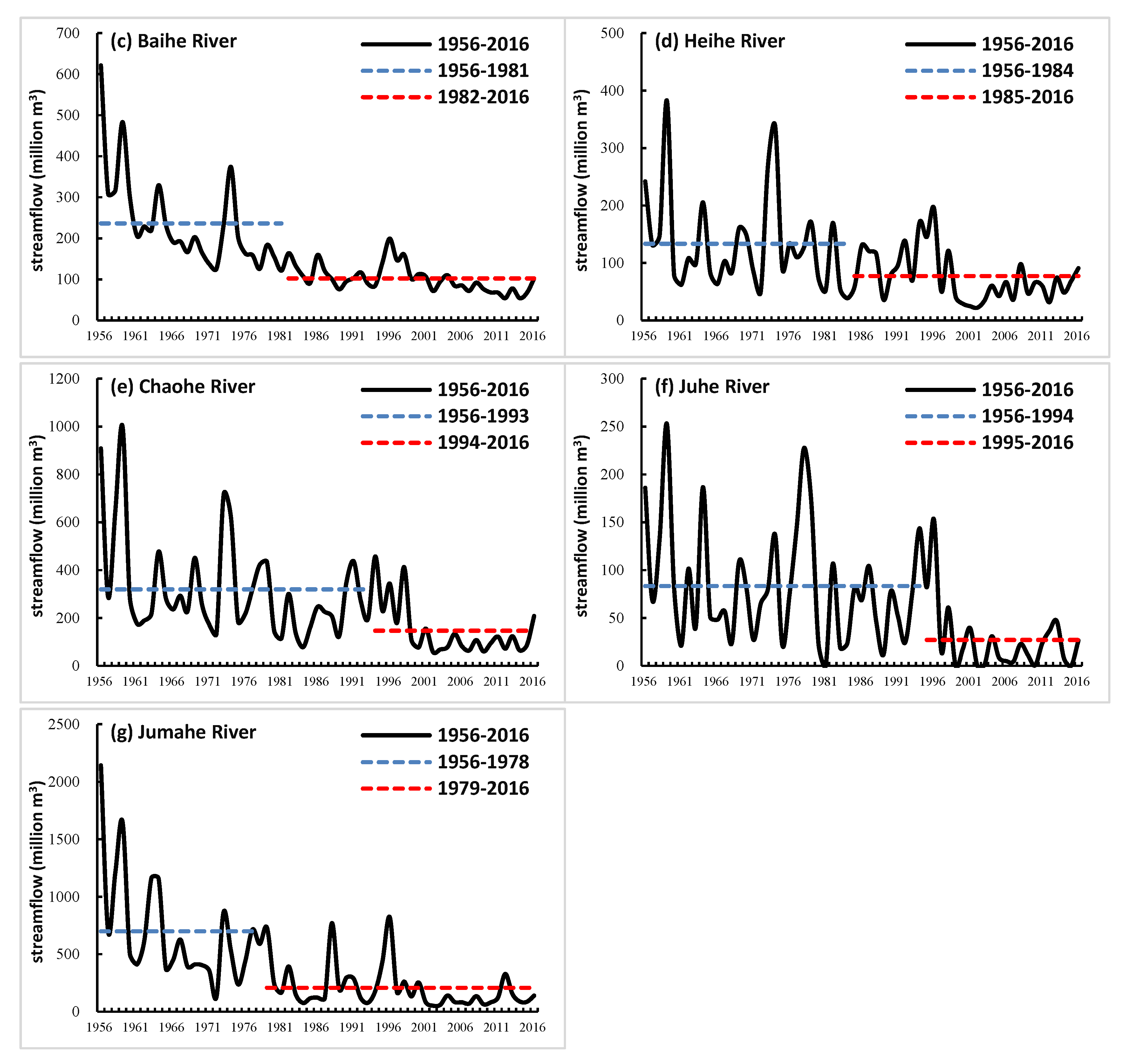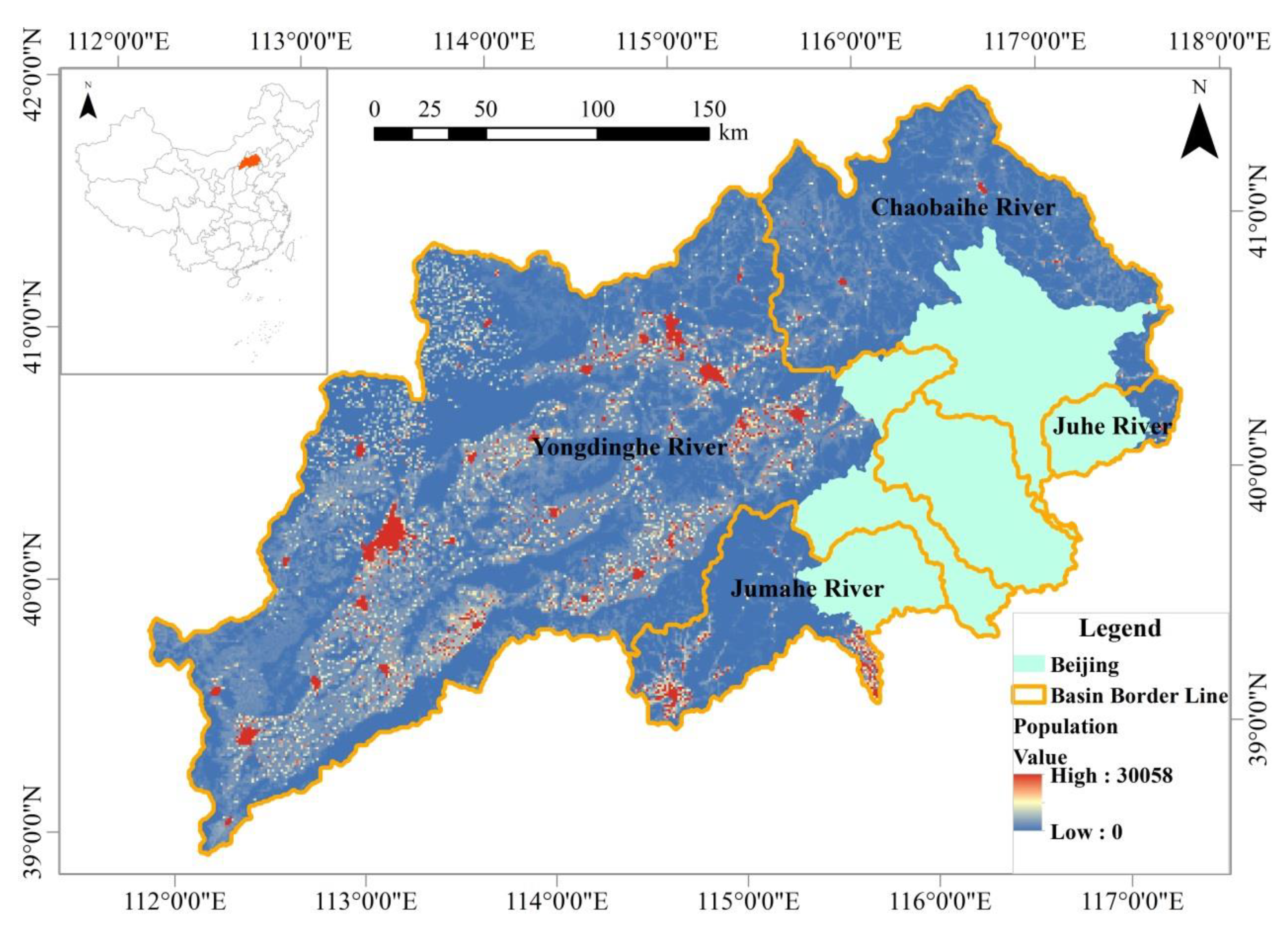Streamflow into Beijing and Its Response to Climate Change and Human Activities over the Period 1956–2016
Abstract
1. Introduction
2. Study Area and Data
2.1. Study Area
2.2. Data Sources and Processing
3. Methodology
3.1. Detection of Trends and Changing Points
3.2. Nonparametric Estimator of Climate Elasticity
3.3. Attribution of Climate Change and Human Activities on the Streamflow
4. Results
4.1. Trends and Changing Points of the Annual Streamflow
4.2. Climate Elasticity of the Streamflow
4.3. Impacts of Climate Change and Human Activities on the Streamflow
5. Discussion
5.1. Rationality of the Attribution Analysis
5.2. Streamflow Change Response to Human Activities
5.3. Adaptive Management of Water Resources
6. Conclusions
Author Contributions
Funding
Conflicts of Interest
References
- Liu, C.; Xia, J. Water problems and hydrological research in the Yellow River and the Huai and Hai River basins of China. Hydrol. Process. 2004, 18, 2197–2210. [Google Scholar] [CrossRef]
- Zheng, H.; Zhang, L.; Zhu, R.; Liu, C.; Sato, Y.; Fukushima, Y. Responses of streamflow to climate and land surface change in the headwaters of the Yellow River Basin. Water Resour. Res. 2009, 45. [Google Scholar] [CrossRef]
- Labat, D.; Goddéris, Y.; Probst, J.L.; Guyot, J.L. Evidence for global runoff increase related to climate warming. Adv. Water Resour. 2004, 27, 631–642. [Google Scholar] [CrossRef]
- De Fraiture, C. Integrated water and food analysis at the global and basin level. An application of WATERSIM. Water Resour. Manag. 2007, 21, 185–198. [Google Scholar] [CrossRef]
- Hejazi, M.I.; Moglen, G.E. Regression-based approach to low flow prediction in the Maryland Piedmont region under joint climate and land use change. Hydrol. Process. 2007, 21, 1793–1801. [Google Scholar] [CrossRef]
- Yang, D.; Shao, W.; Yeh, P.J.F.; Yang, H.; Kanae, S.; Oki, T. Impact of vegetation coverage on regional water balance in the nonhumid regions of China. Water Resour. Res. 2009, 45. [Google Scholar] [CrossRef]
- Gai, L.; Baartman, J.E.M.; Mendoza-Carranza, M.; Wang, F.; Ritsema, C.J.; Geissen, V. A framework approach for unravelling the impact of multiple factors influencing flooding. J. Flood Risk Manag. 2018, 11, 111–126. [Google Scholar] [CrossRef]
- Budyko, M.I. Climate and Life, English ed.; Academic Press: New York, NY, USA, 1974; Volume 508. [Google Scholar]
- Cavalcante, R.B.L.; Pontes, P.R.M.; Souza-Filho, P.W.M.; de Souza, E.B. Opposite effects of climate and land use changes on the annual water balance in the amazon arc of deforestation. Water Resour. Res. 2019, 55, 3092–3106. [Google Scholar] [CrossRef]
- Miao, C.; Ni, J.; Borthwick, A.G.; Yang, L. A preliminary estimate of human and natural contributions to the changes in water discharge and sediment load in the Yellow River. Glob. Planet. Chang. 2011, 76, 196–205. [Google Scholar] [CrossRef]
- Xu, X.; Yang, D.; Yang, H.; Lei, H. Attribution analysis based on the Budyko hypothesis for detecting the dominant cause of runoff decline in Haihe basin. J. Hydrol. 2014, 510, 530–540. [Google Scholar] [CrossRef]
- Choi, W.; Nauth, K.; Choi, J.; Becker, S. Urbanization and rainfall–runoff relationships in the Milwaukee River basin. Prof. Geogr. 2016, 68, 14–25. [Google Scholar] [CrossRef]
- Jonoski, A.; Popescu, I.; Zhe, S.; Mu, Y.; He, Y. Analysis of Flood Storage Area Operations in Huai River Using 1D and 2D River Simulation Models Coupled with Global Optimization Algorithms. Geosciences 2019, 9, 509. [Google Scholar] [CrossRef]
- Hu, S.; Liu, C.; Zheng, H.; Wang, Z.; Yu, J. Assessing the impacts of climate variability and human activities on streamflow in the water source area of Baiyangdian Lake. J. Geogr. Sci. 2012, 22, 895–905. [Google Scholar] [CrossRef]
- Ye, X.; Zhang, Q.; Liu, J.; Li, X.; Xu, C.Y. Distinguishing the relative impacts of climate change and human activities on variation of streamflow in the Poyang Lake catchment, China. J. Hydrol. 2013, 494, 83–95. [Google Scholar] [CrossRef]
- Zhao, G.; Tian, P.; Mu, X.; Jiao, J.; Wang, F.; Gao, P. Quantifying the impact of climate variability and human activities on streamflow in the middle reaches of the Yellow River basin, China. J. Hydrol. 2014, 519, 387–398. [Google Scholar] [CrossRef]
- Zhang, Q.; Liu, J.; Singh, V.P.; Gu, X.; Chen, X. Evaluation of impacts of climate change and human activities on streamflow in the Poyang Lake basin, China. Hydrol. Process. 2016, 30, 2562–2576. [Google Scholar] [CrossRef]
- Wang, M.; Du, L.; Ke, Y.; Huang, M.; Zhang, J.; Zhao, Y.; Gong, H. Impact of climate variabilities and human activities on surface water extents in reservoirs of Yongding River Basin, China, from 1985 to 2016 based on Landsat observations and time series analysis. Remote Sens. 2019, 11, 560. [Google Scholar] [CrossRef]
- Pontes, P.R.; Cavalcante, R.B.; Sahoo, P.K.; da Silva Júnior, R.O.; da Silva, M.S.; Dall’Agnol, R.; Siqueira, J.O. The role of protected and deforested areas in the hydrological processes of Itacaiúnas River Basin, eastern Amazonia. J. Environ. Manag. 2019, 235, 489–499. [Google Scholar] [CrossRef]
- Chiew, F.H.S. Estimation of rainfall elasticity of streamflow in Australia. Hydrol. Sci. J. 2006, 51, 613–625. [Google Scholar] [CrossRef]
- Meng, D.; Mo, X. Assessing the effect of climate change on mean annual runoff in the Songhua River basin, China. Hydrol. Process. 2011, 26, 1050–1061. [Google Scholar] [CrossRef]
- Cavalcante, R.B.; Pontes, P.R.; Tedeschi, R.G.; Costa, C.P.; Ferreira, D.B.; Souza-Filho, P.W.; de Souza, E.B. Terrestrial water storage and Pacific SST affect the monthly water balance of Itacaiúnas river basin (eastern Amazonia). Int. J. Climatol. 2019. [Google Scholar] [CrossRef]
- Sankarasubramanian, A.; Vogel, R.M.; Limbrunner, J.F. Climate elasticity of streamflow in the United States. Water Resour. Res. 2001, 37, 1771–1781. [Google Scholar] [CrossRef]
- Ma, Z.; Kang, S.; Zhang, L.; Tong, L.; Su, X. Analysis of impacts of climate variability and human activity on streamflow for a river basin in arid region of northwest China. J. Hydrol. 2008, 352, 239–249. [Google Scholar] [CrossRef]
- Tan, X.; Gan, T.Y. Contribution of human and climate change impacts to changes in streamflow of Canada. Sci. Rep. 2015, 5, 17767. [Google Scholar] [CrossRef] [PubMed]
- Schaake, J.C. From climate to flow. In Climate Change and US Water Resources; Waggoner, P.E., Ed.; Wiley: New York, NY, USA, 1990; pp. 177–206. [Google Scholar]
- Vogel, R.M.; Wilson, I.; Daly, C. Regional regression models of annual streamflow for the United States. J. Irrig. Drain. Eng. 1999, 125, 148–157. [Google Scholar] [CrossRef]
- Fu, G.; Charles, S.P.; Chiew, F.H.S. A two-parameter climate elasticity of streamflow index to assess climate change effects on annual streamflow. Water Resour. Res. 2007, 43. [Google Scholar] [CrossRef]
- Yang, H.; Yang, D. Derivation of climate elasticity of runoff to assess the effects of climate change on annual runoff. Water Resour. Res. 2011, 47. [Google Scholar] [CrossRef]
- Wang, W.; Shao, Q.; Yang, T.; Peng, S.; Xing, W.; Sun, F.; Luo, Y. Quantitative assessment of the impact of climate variability and human activities on runoff changes: A case study in four catchments of the Haihe River basin, China. Hydrol. Process. 2012, 27, 1158–1174. [Google Scholar] [CrossRef]
- Ma, H.; Yang, D.; Tan, S.K.; Gao, B.; Hu, Q. Impact of climate variability and human activity on streamflow decrease in the Miyun Reservoir catchment. J. Hydrol. 2010, 389, 317–324. [Google Scholar] [CrossRef]
- Li, H.; Zhang, Y.; Vaze, J.; Wang, B. Separating effects of vegetation change and climate variability using hydrological modelling and sensitivity-based approaches. J. Hydrol. 2011, 420–421, 403–418. [Google Scholar] [CrossRef]
- Li, Y.; He, D.; Li, X.; Zhang, Y.; Yang, L. Contributions of climate variability and human activities to runoff changes in the upper catchment of the Red River Basin, China. Water 2016, 8, 414. [Google Scholar] [CrossRef]
- Zhou, Y.; Lai, C.; Wang, Z.; Chen, X.; Zeng, Z.; Chen, J.; Bai, X. Quantitative evaluation of the impact of climate change and human activity on runoff change in the Dongjiang River Basin, China. Water 2018, 10, 571. [Google Scholar] [CrossRef]
- Beijing Water Authority (BWA). Report of the Second Water Resources Investigation and Evaluation in Beijing; Internal Report; BWA: Beijing, China, Unpublished work; 2003. [Google Scholar]
- Allen, R.G.; Pereira, L.S.; Raes, D.; Smith, M. Crop. Evapotranspiration-Guidelines for Computing Crop Water Requirements-FAO Irrigation and Drainage Paper 56; Food and Agricultural Organization of the United Nations (FAO): Rome, Italy, 1998; p. D05109. [Google Scholar]
- Mann, H.B. Nonparametric tests against trend. Econometrica 1945, 13, 245–259. [Google Scholar] [CrossRef]
- Kendall, M.G. Rank Correlation Measures; Charles Griffin and Company, Ltd.: London, UK, 1975; Volume 202, p. 15. [Google Scholar]
- Yue, S.; Pilon, P.; Cavadias, G. Power of the Mann–Kendall and Spearman’s rho tests for detecting monotonic trends in hydrological series. J. Hydrol. 2002, 259, 254–271. [Google Scholar] [CrossRef]
- Burn, D.H.; Elnur, M.A.H. Detection of hydrologic trends and variability. J. Hydrol. 2002, 255, 107–122. [Google Scholar] [CrossRef]
- Xia, J.; Zeng, S.; Du, H.; Zhan, C. Quantifying the effects of climate change and human activities on runoff in the water source area of Beijing, China. Hydrol. Sci. J. 2014, 59, 1794–1807. [Google Scholar] [CrossRef]
- Moraes, J.M.; Pellegrino, G.Q.; Ballester, M.V.; Martinelli, L.A.; Victoria, R.L.; Krusche, A.V. Trends in hydrological parameters of a southern Brazilian watershed and its relation to human induced changes. Water Resour. Manag. 1998, 12, 295–311. [Google Scholar] [CrossRef]
- Zhang, Y.; Guan, D.; Jin, C.; Wang, A.; Wu, J.; Yuan, F. Analysis of impacts of climate variability and human activity on streamflow for a river basin in northeast China. J. Hydrol. 2011, 410, 239–247. [Google Scholar] [CrossRef]
- Zhang, L.; Dawes, W.R.; Walker, G.R. Response of mean annual evapotranspiration to vegetation changes at catchment scale. Water Resour. Res. 2001, 37, 701–708. [Google Scholar] [CrossRef]
- Buishand, T.A. Some methods for testing the homogeneity of rainfall records. J. Hydrol. 1982, 58, 11–27. [Google Scholar] [CrossRef]
- Yang, D.; Sun, F.; Liu, Z.; Cong, Z.; Ni, G.; Lei, Z. Analyzing spatial and temporal variability of annual water-energy balance in nonhumid regions of China using the Budyko hypothesis. Water Resour. Res. 2007, 43. [Google Scholar] [CrossRef]
- Wang, G.; Xia, J.; Chen, J. Quantification of effects of climate variations and human activities on runoff by a monthly water balance model: A case study of the Chaobai River basin in northern China. Water Resour. Res. 2009, 45. [Google Scholar] [CrossRef]
- Yang, Y.; Tian, F. Abrupt change of runoff and its major driving factors in Haihe River Catchment, China. J. Hydrol. 2009, 374, 373–383. [Google Scholar] [CrossRef]
- Mo, C.; Ruan, Y.; Mo, G. Studying Response of runoff to climate change and human activities based on elastic coefficient. J. Hydrol. 2018, 38, 41–45. (In Chinese) [Google Scholar]
- Sun, Y.; Tian, F.; Yang, L.; Hu, H. Exploring the spatial variability of contributions from climate variation and change in catchment properties to streamflow decrease in a mesoscale basin by three different methods. J. Hydrol. 2014, 508, 170–180. [Google Scholar] [CrossRef]
- Zhan, C.; Niu, C.; Song, X.; Xu, C. The impacts of climate variability and human activities on streamflow in Bai River basin, northern China. Hydrol. Res. 2012, 44, 875–885. [Google Scholar] [CrossRef]
- Liu, J.; Zhang, Q.; Singh, V.P.; Shi, P. Contribution of multiple climatic variables and human activities to streamflow changes across China. J. Hydrol. 2016, 545, 145–162. [Google Scholar] [CrossRef]








| Station | Area (km2) | M-K test | t-test Changing Point | Detected Changing Point | Mean Annual Streamflow (Million m3) | Change Ratio (%) | ||
|---|---|---|---|---|---|---|---|---|
| Z | Changing Point | Baseline Period | Changed Period | |||||
| Total streamflow | −7.52 | 1982–1983 | 1982 | 1982 | 2830 | 872 | −69% | |
| Bahaoqiao | 39,339 | −8.32 | 1982–1983 | 1983 | 1983 | 1185 | 207 | −83% |
| Xiabao | 4015 | −8.06 | 1980–1982 | 1983 | 1982 | 236 | 102 | −57% |
| Sandaoying | 1600 | −3.74 | 1983–1988 | 1985 | 1985 | 138 | 78 | −44% |
| Gubeikou | 4701 | −5.08 | 1994–1995 | 1994 | 1994 | 362 | 175 | −52% |
| Sangyuan | 375 | −4.29 | 1994–1995 | 1996/1998 | 1995 | 83 | 27 | −68% |
| Dashadi | 4446 | −5.99 | 1971–1980 | 1979 | 1979 | 700 | 208 | −70% |
| River | Hydrological Station | Data Period | Long-Term Mean Value (mm) | Climate Elasticity | |||
|---|---|---|---|---|---|---|---|
| Q | P | E0 | εP | εE0 | |||
| Total streamflow | 1956–1981 | 48 | 501 | 863 | 1.66 | −3.73 | |
| 1982–2016 | 15 | 475 | 854 | 2.14 | −4.03 | ||
| 1956–2016 | 29 | 486 | 858 | 2.45 | −3.77 | ||
| Yongdinghe River | Bahaoqiao | 1956–1982 | 30 | 467 | 890 | 1.18 | −3.65 |
| 1983–2016 | 5 | 439 | 886 | 2.30 | −4.75 | ||
| 1956–2016 | 16 | 451 | 888 | 2.19 | −3.89 | ||
| Baihe River | Xiabao | 1956–1981 | 59 | 516 | 841 | 1.12 | −1.94 |
| 1982–2016 | 25 | 515 | 799 | 0.24 | −1.81 | ||
| 1956–2016 | 40 | 515 | 817 | 0.75 | −0.47 | ||
| Heihe River | Sandaoying | 1956–1984 | 87 | 564 | 789 | 2.49 | −2.36 |
| 1985–2016 | 49 | 543 | 738 | 2.37 | −1.59 | ||
| 1956–2016 | 65 | 552 | 760 | 2.54 | −1.27 | ||
| Chaohe River | Gubeikou | 1956–1993 | 77 | 596 | 736 | 2.67 | −2.89 |
| 1994–2016 | 37 | 561 | 712 | 2.51 | −1.37 | ||
| 1956–2016 | 54 | 576 | 722 | 2.94 | −3.11 | ||
| Juhe River | Sangyuan | 1956–1994 | 222 | 751 | 786 | 2.39 | −1.11 |
| 1995–2016 | 72 | 675 | 787 | 4.45 | −8.39 | ||
| 1956–2016 | 168 | 724 | 786 | 3.05 | −1.77 | ||
| Jumahe River | Dashadi | 1956–1978 | 157 | 662 | 811 | 2.07 | −3.71 |
| 1979–2016 | 47 | 600 | 815 | 2.93 | −4.14 | ||
| 1956–2016 | 89 | 623 | 814 | 3.00 | −4.37 | ||
| River | ΔQ (mm) | ΔP (mm) | ΔE (mm) | ΔQP (mm) | ΔQE (mm) | ΔQC (mm) | ΔQC/ΔQ | ΔQH (mm) | ΔQH/ΔQ |
|---|---|---|---|---|---|---|---|---|---|
| Total streamflow Yongdinghe River | −33 −25 | −26 −28 | −8 −5 | −6.1 −3.9 | 1.8 0.6 | −4.3 −3.4 | 13% 13% | −28.9 −21.5 | 87% 87% |
| Baihe River | −33 | −1 | −42 | −0.1 | 1.4 | 1.3 | −4% | −34.7 | 104% |
| Heihe River | −38 | −22 | −52 | −8.4 | 7.2 | −1.2 | 3% | −36.5 | 97% |
| Chaohe River | −40 | −35 | −24 | −13.3 | 7.9 | −5.4 | 14% | −34.5 | 86% |
| Juhe River | −150 | −76 | 2 | −68.8 | −0.8 | −69.6 | 46% | −80.7 | 54% |
| Jumahe River | −111 | −62 | 4 | −44.0 | −3.4 | −47.4 | 43% | −63.2 | 57% |
| Catchment | Hydrological Station | Study Period | Method | Contribution | Source | |
|---|---|---|---|---|---|---|
| Climate Change (%) | Human Activities (%) | |||||
| Baihe | Xiabao | 1956–2005 | Budyko hypothesis | 16.5 | 83.5 | Xu, et al. [11] |
| Heihe | Sandaoying | 1956–2000 | Distributed time-variant gain model | 30 | 70 | Xu, et al. [11] |
| Chaohe | Daiying | 1956–2005 | Distributed time-variant gain model | 22.1 | 77.9 | Xu, et al. [11] |
| Baihe | - | 1961–2001 | Distributed time-variant gain model | 29.6 | 70.4 | Wang et al. [47] |
| Chaohe | - | 1961–2001 | Distributed time-variant gain model | 31.4 | 68.6 | Wang et al. [47] |
| Baihe | Zhangjiafen | 1986–1998 | SIMHYD model | 37.5 | 62.5 | Zhan et al. [51] |
| Chaohe | Daiying | 1957–2000 | Two-parameter model method | 46 | 54 | Wang et al. [30] |
| Chaohe | Daiying | 1957–2000 | Hydrological sensitivity analysis method | 34 | 66 | Wang et al. [30] |
| Chaohe | Daiying | 1957–2000 | Climate elasticity method | 35 | 65 | Wang et al. [30] |
© 2020 by the authors. Licensee MDPI, Basel, Switzerland. This article is an open access article distributed under the terms and conditions of the Creative Commons Attribution (CC BY) license (http://creativecommons.org/licenses/by/4.0/).
Share and Cite
Mu, X.; Wang, H.; Zhao, Y.; Liu, H.; He, G.; Li, J. Streamflow into Beijing and Its Response to Climate Change and Human Activities over the Period 1956–2016. Water 2020, 12, 622. https://doi.org/10.3390/w12030622
Mu X, Wang H, Zhao Y, Liu H, He G, Li J. Streamflow into Beijing and Its Response to Climate Change and Human Activities over the Period 1956–2016. Water. 2020; 12(3):622. https://doi.org/10.3390/w12030622
Chicago/Turabian StyleMu, Xing, Hao Wang, Yong Zhao, Huan Liu, Guohua He, and Jinming Li. 2020. "Streamflow into Beijing and Its Response to Climate Change and Human Activities over the Period 1956–2016" Water 12, no. 3: 622. https://doi.org/10.3390/w12030622
APA StyleMu, X., Wang, H., Zhao, Y., Liu, H., He, G., & Li, J. (2020). Streamflow into Beijing and Its Response to Climate Change and Human Activities over the Period 1956–2016. Water, 12(3), 622. https://doi.org/10.3390/w12030622






